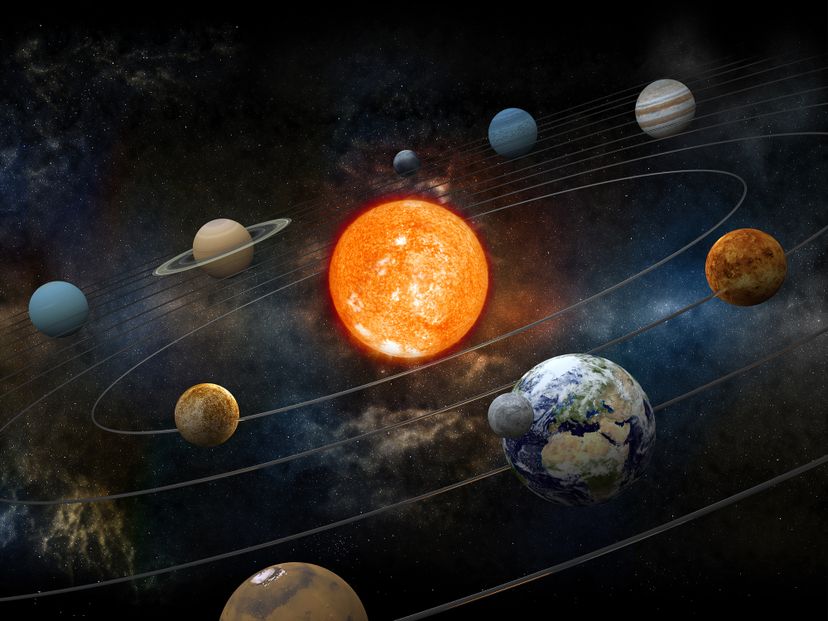Beyond the asteroid belt lies a realm vastly different from the rocky inner planets (Mercury, Venus, Mars and our home planet). Among the four outer planets — Jupiter, Saturn, Uranus and Neptune — are colossal gas giants with distinct characteristics and features that continue to captivate our imagination. Composed primarily of hydrogen and helium (with some methane, water and ammonia in the mix), these Jovian planets possess vast atmospheres, rocky cores, numerous moons and, in some cases, intricate systems of rings. In contrast, a dwarf planet, though not found in this specific context, is a smaller celestial body that shares some similarities with these gas giants.
As we delve deeper into the outer solar system, we will uncover the unique traits of each gas giant, exploring their stormy atmospheres, icy compositions and enigmatic moons. The sheer size and complexity of the gas giants make them difficult to comprehend, as their nature diverges significantly from the terrestrial planets with which we are familiar. Nevertheless, their peculiar characteristics offer tantalizing clues about the formation and evolution of our solar system.
As we journey through the realm of the gas giants, we will witness the colossal planet Jupiter, the ringed beauty Saturn, the tilted world Uranus and the mysterious blue giant Neptune, each with a story to tell.
Jupiter: The Colossal Planet
Boasting an atmosphere composed primarily of hydrogen and helium, Jupiter, the largest planet in our solar system, reigns supreme with its massive size and impressive characteristics. Bands of ammonia clouds, which display a vivid array of colors, adorn Jupiter’s upper atmosphere. The most famous feature of Jupiter’s stormy skies is the Great Red Spot, a colossal storm that has been raging for at least a century. This giant storm has decreased in size over the years, but it was once so immense that it could fit three Earth-sized planets within its boundaries. Now, it can only fit one Earth.
The colossal size of Jupiter is not its only claim to fame; its more than 75 known moons hold many secrets waiting to be discovered. Among these satellites are the four Galilean moons: Io, Europa, Ganymede, and Callisto. Named after astronomer Galileo Galilei, these Galilean moons possess unique characteristics and potential for life (particularly Europa). From the volcanic landscape of Io to the icy oceans of Europa, these moons are prime targets for future exploration and may hold the key to understanding the origins of life in our solar system.
Saturn: The Ringed Beauty
Saturn, the second-largest planet in our solar system, captivates stargazers with its exquisite rings. These stunning rings — composed of ice, dust and rocks — encircle the planet, creating a celestial spectacle like no other. The origin of Saturn’s rings remains a subject of scientific debate, with hypotheses suggesting that they were either remnants of a disrupted moon or material that failed to coalesce during the planet’s formation. Regardless of their origin, the rings of Saturn remain one of the most iconic features of our solar system.
Complementing its mesmerizing rings, Saturn also boasts a collection of more than 100 moons, each with unique features and landscapes. Among these satellites is Titan, Saturn’s largest moon and a fascinating world in its own right. Larger than Earth’s moon and even the planet Mercury, Titan is enveloped in a thick atmosphere and possesses liquid methane lakes on its surface. The intriguing characteristics of Titan and Saturn’s other icy satellites offer a wealth of opportunities for future exploration and the potential discovery of life beyond Earth.
Uranus: The Tilted World
Venturing further into the outer solar system, we encounter Uranus, a gas giant with a unique twist. Unlike any other planet in our solar system, Uranus, which has a nearly 90-degree tilt — rotates horizontally, with its poles almost directly facing the sun. This peculiar tilt gives rise to extreme seasonal changes, as one pole basks in sunlight for decades while the other is plunged into darkness. The icy composition of Uranus sets it apart from the gas giants, as it contains a higher percentage of water, ammonia and methane in its atmosphere. (Neptune is also an ice giant.)
Uranus has 27 moons, each named after characters from Shakespeare’s plays and Alexander Pope’s poems. Among these satellites, the five largest — Miranda, Ariel, Umbriel, Titania and Oberon — display unique features and landscapes, such as Miranda’s chaotic terrain and Ariel’s bright icy surface.
The peculiar characteristics of Uranus and its moons provide a fascinating glimpse into the diversity of celestial bodies in our solar system and the potential for life in the most unexpected places.
Neptune: The Mysterious Blue Giant
The mysterious blue giant Neptune, the most distant of the gas giants, completes our journey through the realm of the outer planets. Its enigmatic blue hue is primarily attributed to the presence of frozen methane in its atmosphere. The extreme cold at the top of Neptune’s clouds reaches an average temperature of minus 200 degrees Celsius (minus 328 degrees Fahrenheit), making it one of the coldest places in our solar system. Despite its frigid climate, Neptune’s atmosphere has some of the most powerful winds, reaching speeds of 1,100 mph (1,700 km/h), more than the speed of sound.
Neptune has 14 known moons, including its largest moon, Triton. Triton is an intriguing world, as it orbits Neptune in a retrograde motion, opposite to the planet’s rotation. This captive moon also boasts geysers that spout nitrogen gas, further adding to the mystique of this distant world.
The exploration of Neptune and its moons holds the potential for uncovering new insights into the formation and evolution of our solar system, and perhaps even the existence of life in these far-flung celestial realms.
